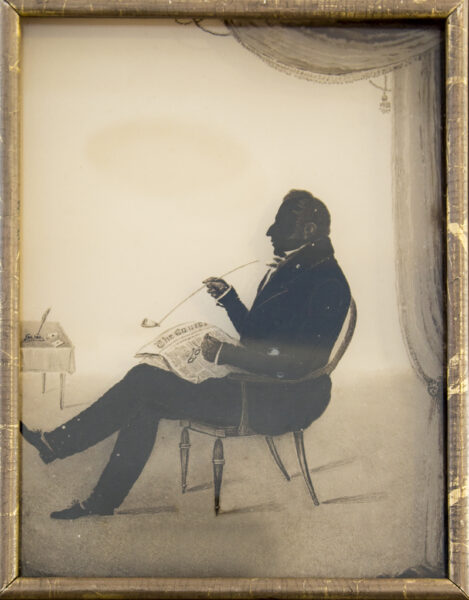
John Woodhouse was a well-known artist in Alnwick in the early 1800’s. A newspaper report stated that “it was hardly possible to go into any of the houses of the principal residents without seeing one or more examples of this artist’s ability”.
John then opened a studio in the centre of Newcastle, where he appears to have secured an even higher-class clientele. The portrait above is believed to be of Dr Thomas Masterman Winterbottom, a Newcastle physician, philanthropist and abolitionist of national renown, and is two of John’s works held by the Laing Art Gallery.
We cannot be certain whether in his early life the description ‘painter’ indicates that he was exclusively an artist or a house painter; probably the latter, since, if he was an artist, he would probably have been so described both in directory entries and on his trade label.
What prompted John Woodhouse to paint silhouettes is debatable. Being also a glazier, he had ready access to suitable glass and likely worked on stained glass projects; being a house painter he had ready access to paint. Perhaps the loss of a close friend prompted him to capture an image as a lasting tribute. His earliest known profile is dated 1821 though the majority of his work was completed during the 1830s and 1840s. Unlike other silhouette and portrait artists, Woodhouse did not paint from live sittings but from recollection. A contemporary account praised his remarkable ‘faculty of retaining the exact forms of objects for a length of time after he has seen them’.
Although access to local trade directories has been limited to four editions, they, coupled with other resources, provide a rough timeline to Woodhouse’s movements:
- 1821-23 – Painter, Bondgate Street, Alnwick
- 1822 – dated silhouette taken in Newcastle
- 1827-29 – Painter in Shade, 9 Blackett Street, Newcastle
- Pigot’s 1829 – Portrait Painter, 9 Blackett Street, Newcastle
- Pigot’s 1834 – Portrait Painter, Lower Pearson Street, North Shields
- May 1835 – Newcastle Courant notice to creditors of ‘John Woodhouse late of Newcastle upon Tyne, painter’
- 1841 Census – living in Back Street, Tynemouth along with 53-year old Anna Woodhouse who may have been his sister or his wife
- 1850 – Newcastle Courant announces his death at Alnwick ‘on 27th [May], aged 77, Mr John Woodhouse, artist, formerly of Newcastle’
Woodhouse’s surviving body of work is small. Amongst his named sitters were: Thomas Fell, Tynemouth (died 183*), Mr Thorburn (died 1833), Charles & Samuel Dixon, boot & shoe makers, Newcastle upon Tyne (1840), Walter Dixon, corn merchant & miller, Archibald Reed, six times Mayor of Newcastle, Rev Christopher Reed, vicar of Christ Church Tynemouth (1842), Matthew Plummer Newcastle upon Tyne (1842), Robert Ridley, supervisor of excise (died 1842), John Charlton (on horseback), Dr Thomas Masterman Winterbottom (dated 1821; d.1859), & Col. Reid
The illustrated bust-length examples of his work appear to be of earlier date than the full-length. It is difficult to date his bust-length silhouettes with accuracy; they appear to have been painted before 1820, and some examples might date from as early as 1810. He had certainly begun to paint full-length work by 1821, for a signed example bearing this date was sold by Sotheby and Company, London, on 30 April 1973. This shows the subject (one George Wilson) in an indoor setting, with a desk, a chair, and a curtain.
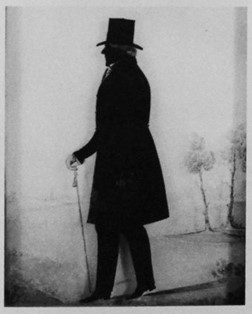
Portrait of an unknown man
Silhouette painted on glass
March 1825
11 ½ x 8 1/2 in./293 x 216mm.
On the backs of some of what are apparently his later full-length pieces Woodhouse gave careful instructions for their hanging. Woodiwiss owned an example (the profile of a Mr Thorburn) which its possessor was asked to place ‘not exceeding 5 feet on a side-light’. Another silhouette, in my collection, must be placed ‘upon a side or back light not exceeding 4 ft. 6 in. in height from the ground floor’.
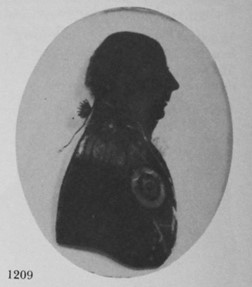
Portrait of anknown army officer
Silhouette painted on convex glass, backed with plaster
c. 1810
Few of Woodhouse’s bust-length profiles are available for description. Known examples are painted much in the style of Rosenberg or William Hamlet the elder. No doubt they are faithful likenesses, for Woodhouse does not seem to have flattered his sitters. Their hair is represented as wild and wiry, and the thin tye-wigs of the period are shown as thin and scrappy. Where transparency was required, Woodhouse used a needle. His bust-line finish tends to a concavity near the centre. These silhouettes are painted on convex glass and housed either in small oval frames of turned wood (more nearly circular than those used during the 1790s) or in papier mâché frames.
Most of the charm of Woodhouse’s full-length silhouettes lies in the lightly painted backgrounds, which have a ghostly look, apparently achieved by light touching with an almost dry brush, while density in the background decoration is effected with a coarser brush. On the profile itself, such details as the sitter’s hand, or the lining of a coat, are also rendered in this fashion. Hand formation is, however, a little clumsy, the fingers appearing rather thick and large, despite the delicate fashion in which they are drawn. Hair seems to have been drawn entirely with the needle. Woodhouse does not seem to have used the fingerprinting technique.
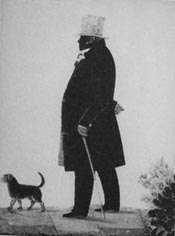
Mr Thorburn and his dog
Silhouette painted on glass
December 1833
11 ½ x 8 ½ in./293 x 216mm.
Frame: oak
Although the painting of detail is not fine, these full-length silhouettes on flat glass are full of character, and, like the bust-length pieces, appear life-like. Although Woodhouse painted ‘Mr Thorburn and his dog’ ‘from recollection’, in this silhouette, as in other examples, he seems to have a keen sense of observation to which he probably owed more than to artistic training. His full-length silhouettes, moreover, are certainly seen to best advantage when his hanging instructions are followed, and the painted figure throws a true shade’ against the ghostly background.
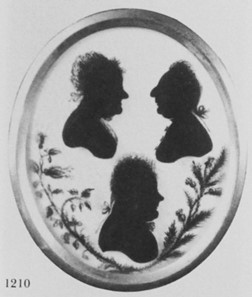
Members of an unknown family
Group of three silhouettes painted on convex glass, backed with plaster
c. 1810-12
3 x 2 ¾ in./77 x 70mm.
Because the distinctive style of John Woodhouse was to paint in ink on glass, this may be why relatively few of his works appear to have survived. The Bailiffgate Museum and Gallery is hence very keen to hear from any Gazette reader who has, or knows of anyone that has, any painting in the style of that shown; as they are considering a feature on John Woodhouse. If it is not possible to borrow any particular work for investigation, they would be happy to have it properly scanned to create a reproduction.

